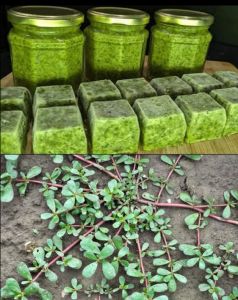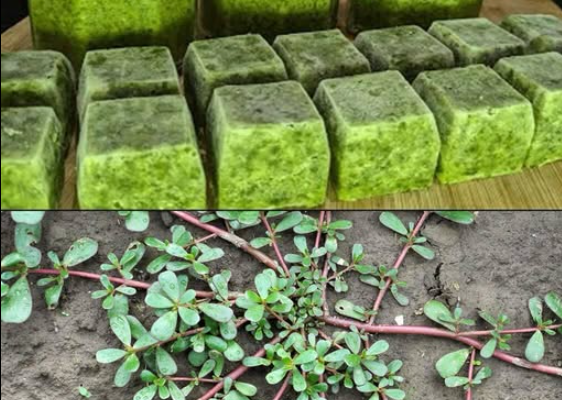What Happens to Your Body When You Eat Purslane Every Day — Especially After 60
As we age, maintaining good health becomes more crucial than ever. People over 60 often seek natural ways to boost vitality, improve digestion, and support overall wellness. One underappreciated superfood that can offer a variety of benefits, especially for older adults, is purslane. This humble, leafy green is often dismissed as a common weed, but purslane is a nutritional powerhouse packed with vitamins, minerals, and antioxidants that can transform your health when consumed regularly.
What is Purslane?
Purslane (Portulaca oleracea) is a succulent plant with fleshy, green leaves and a slightly lemony flavor. It grows wild in many parts of the world and has been used for centuries in traditional medicine and cuisine. Despite its common appearance, purslane boasts one of the highest levels of omega-3 fatty acids found in any plant source — making it especially valuable for those seeking heart-healthy foods.
Nutritional Profile of Purslane
Purslane’s benefits stem from its rich nutritional composition:
-
Omega-3 fatty acids: Specifically alpha-linolenic acid (ALA), a plant-based omega-3.
-
Vitamins: High in vitamins A, C, and some B vitamins.
-
Minerals: Contains magnesium, potassium, calcium, and iron.
-
Antioxidants: Includes betalain pigments, vitamin C, vitamin E, and glutathione.
-
Fiber: Supports digestive health.
-
Low calories: Great for weight management.
1. Heart Health Support
Heart disease risk increases with age, but eating purslane every day can help protect your cardiovascular system. The omega-3 fatty acids in purslane are known to reduce inflammation and lower levels of LDL (bad) cholesterol. They also help prevent blood clot formation, which can reduce the risk of heart attacks and strokes.
Purslane’s potassium content helps regulate blood pressure by balancing sodium levels in the body. For adults over 60, keeping blood pressure in check is vital, and including potassium-rich foods like purslane can complement prescribed medications or act as preventive care.
2. Anti-Inflammatory Benefits
Chronic inflammation is a silent contributor to many age-related diseases, including arthritis, Alzheimer’s, and diabetes. Purslane contains powerful antioxidants and anti-inflammatory compounds such as vitamins A and C, and betalains, which fight free radicals and reduce oxidative stress.
Eating purslane daily may ease joint pain and stiffness by calming inflammatory processes. This can be a natural complement to traditional treatments for arthritis and other inflammatory conditions that affect older adults.
3. Enhanced Brain Function
Cognitive decline is a major concern as we age. Studies suggest that omega-3 fatty acids improve brain health by supporting neuronal function and reducing inflammation in the brain. The high levels of ALA in purslane contribute to this effect.
Additionally, antioxidants in purslane protect brain cells from damage caused by oxidative stress, potentially slowing memory loss and supporting sharper mental clarity over time.
4. Improved Digestive Health
Fiber is key to maintaining a healthy digestive system, which can slow down with age. Purslane is a good source of dietary fiber, helping promote regular bowel movements and preventing constipation — a common problem in older adults.
Purslane also contains mucilage, a gelatinous substance that soothes the digestive tract, potentially reducing symptoms of acid reflux and gastritis.
5. Blood Sugar Regulation
Type 2 diabetes risk rises with age, and managing blood sugar levels is critical. Purslane has shown promise in helping regulate blood glucose. Some animal studies indicate purslane extracts can improve insulin sensitivity and reduce blood sugar spikes.
While more research in humans is needed, incorporating purslane as part of a balanced diet can be a helpful strategy for those looking to maintain healthy blood sugar levels naturally.
6. Bone Health Support
Aging often leads to decreased bone density and higher risk of osteoporosis. Purslane contains calcium, magnesium, and vitamin K — all essential nutrients for maintaining strong bones.
Regular consumption of purslane can contribute to better bone mineralization and may help prevent fractures or bone-related ailments.
7. Skin and Eye Health
Vitamins A and C in purslane are crucial for maintaining healthy skin and eyes. Vitamin A supports skin cell regeneration and protects against dryness and wrinkles, while vitamin C promotes collagen production, improving skin elasticity.
For eye health, vitamin A is essential to prevent conditions like age-related macular degeneration and dry eyes, common problems in older adults.
8. Weight Management and Metabolism Boost
Because purslane is low in calories but high in fiber, it can help promote satiety and reduce overeating. This is beneficial for those over 60 aiming to manage weight, which is often more challenging due to slower metabolism.
Purslane’s nutrients also support metabolic processes, helping your body efficiently convert food into energy.
How to Incorporate Purslane Into Your Daily Diet
Eating purslane every day is easier than you think. Here are some simple ways to add it to your meals:
-
Salads: Use fresh purslane leaves as a base or mix them with other greens.
-
Smoothies: Blend purslane with fruits and vegetables for a nutritious drink.
-
Soups and stews: Add purslane near the end of cooking for extra nutrients.
-
Sautéed greens: Quickly sauté with garlic and olive oil as a side dish.
-
Sandwiches and wraps: Use fresh purslane instead of lettuce for a tangy crunch.
Safety and Considerations
Purslane is generally safe for daily consumption, but there are a few things to note:
-
Oxalates: Purslane contains oxalates, which can contribute to kidney stones in susceptible individuals. If you have a history of kidney stones, consult your doctor before eating large amounts.
-
Pesticides: If foraging purslane wild, be cautious of contaminated areas.
-
Allergic reactions: Rare, but if you experience any discomfort, stop eating and consult a healthcare professional.
Conclusion: Why Purslane is a Smart Superfood Choice After 60
Eating purslane every day after 60 can support heart, brain, and bone health, ease inflammation, aid digestion, and even help regulate blood sugar. Its dense nutritional profile offers a natural way to bolster your body’s defenses against age-related ailments while keeping your metabolism and skin glowing.
With its mild flavor and versatile culinary uses, purslane can easily become a staple in your diet. Whether you enjoy it fresh in salads or cooked into your favorite dishes, this humble plant has the potential to bring remarkable health benefits that support your journey to healthy aging.
What Happens to Your Body When You Eat Purslane Every Day — Especially After 60
As we age, maintaining good health becomes more crucial than ever. People over 60 often seek natural ways to boost vitality, improve digestion, and support overall wellness. One underappreciated superfood that can offer a variety of benefits, especially for older adults, is purslane. This humble, leafy green is often dismissed as a common weed, but purslane is a nutritional powerhouse packed with vitamins, minerals, and antioxidants that can transform your health when consumed regularly.
What is Purslane?
Purslane (Portulaca oleracea) is a succulent plant with fleshy, green leaves and a slightly lemony flavor. It grows wild in many parts of the world and has been used for centuries in traditional medicine and cuisine. Despite its common appearance, purslane boasts one of the highest levels of omega-3 fatty acids found in any plant source — making it especially valuable for those seeking heart-healthy foods.
Nutritional Profile of Purslane
Purslane’s benefits stem from its rich nutritional composition:
-
Omega-3 fatty acids: Specifically alpha-linolenic acid (ALA), a plant-based omega-3.
-
Vitamins: High in vitamins A, C, and some B vitamins.
-
Minerals: Contains magnesium, potassium, calcium, and iron.
-
Antioxidants: Includes betalain pigments, vitamin C, vitamin E, and glutathione.
-
Fiber: Supports digestive health.
-
Low calories: Great for weight management.
1. Heart Health Support
Heart disease risk increases with age, but eating purslane every day can help protect your cardiovascular system. The omega-3 fatty acids in purslane are known to reduce inflammation and lower levels of LDL (bad) cholesterol. They also help prevent blood clot formation, which can reduce the risk of heart attacks and strokes.
Purslane’s potassium content helps regulate blood pressure by balancing sodium levels in the body. For adults over 60, keeping blood pressure in check is vital, and including potassium-rich foods like purslane can complement prescribed medications or act as preventive care.
2. Anti-Inflammatory Benefits
Chronic inflammation is a silent contributor to many age-related diseases, including arthritis, Alzheimer’s, and diabetes. Purslane contains powerful antioxidants and anti-inflammatory compounds such as vitamins A and C, and betalains, which fight free radicals and reduce oxidative stress.
Eating purslane daily may ease joint pain and stiffness by calming inflammatory processes. This can be a natural complement to traditional treatments for arthritis and other inflammatory conditions that affect older adults.
3. Enhanced Brain Function
Cognitive decline is a major concern as we age. Studies suggest that omega-3 fatty acids improve brain health by supporting neuronal function and reducing inflammation in the brain. The high levels of ALA in purslane contribute to this effect.
Additionally, antioxidants in purslane protect brain cells from damage caused by oxidative stress, potentially slowing memory loss and supporting sharper mental clarity over time.
4. Improved Digestive Health
Fiber is key to maintaining a healthy digestive system, which can slow down with age. Purslane is a good source of dietary fiber, helping promote regular bowel movements and preventing constipation — a common problem in older adults.
Purslane also contains mucilage, a gelatinous substance that soothes the digestive tract, potentially reducing symptoms of acid reflux and gastritis.
5. Blood Sugar Regulation
Type 2 diabetes risk rises with age, and managing blood sugar levels is critical. Purslane has shown promise in helping regulate blood glucose. Some animal studies indicate purslane extracts can improve insulin sensitivity and reduce blood sugar spikes.
While more research in humans is needed, incorporating purslane as part of a balanced diet can be a helpful strategy for those looking to maintain healthy blood sugar levels naturally.
6. Bone Health Support
Aging often leads to decreased bone density and higher risk of osteoporosis. Purslane contains calcium, magnesium, and vitamin K — all essential nutrients for maintaining strong bones.
Regular consumption of purslane can contribute to better bone mineralization and may help prevent fractures or bone-related ailments.
7. Skin and Eye Health
Vitamins A and C in purslane are crucial for maintaining healthy skin and eyes. Vitamin A supports skin cell regeneration and protects against dryness and wrinkles, while vitamin C promotes collagen production, improving skin elasticity.
For eye health, vitamin A is essential to prevent conditions like age-related macular degeneration and dry eyes, common problems in older adults.
8. Weight Management and Metabolism Boost
Because purslane is low in calories but high in fiber, it can help promote satiety and reduce overeating. This is beneficial for those over 60 aiming to manage weight, which is often more challenging due to slower metabolism.
Purslane’s nutrients also support metabolic processes, helping your body efficiently convert food into energy.
How to Incorporate Purslane Into Your Daily Diet
Eating purslane every day is easier than you think. Here are some simple ways to add it to your meals:
-
Salads: Use fresh purslane leaves as a base or mix them with other greens.
-
Smoothies: Blend purslane with fruits and vegetables for a nutritious drink.
-
Soups and stews: Add purslane near the end of cooking for extra nutrients.
-
Sautéed greens: Quickly sauté with garlic and olive oil as a side dish.
-
Sandwiches and wraps: Use fresh purslane instead of lettuce for a tangy crunch.
Safety and Considerations
Purslane is generally safe for daily consumption, but there are a few things to note:
-
Oxalates: Purslane contains oxalates, which can contribute to kidney stones in susceptible individuals. If you have a history of kidney stones, consult your doctor before eating large amounts.
-
Pesticides: If foraging purslane wild, be cautious of contaminated areas.
-
Allergic reactions: Rare, but if you experience any discomfort, stop eating and consult a healthcare professional.
Conclusion: Why Purslane is a Smart Superfood Choice After 60
Eating purslane every day after 60 can support heart, brain, and bone health, ease inflammation, aid digestion, and even help regulate blood sugar. Its dense nutritional profile offers a natural way to bolster your body’s defenses against age-related ailments while keeping your metabolism and skin glowing.
With its mild flavor and versatile culinary uses, purslane can easily become a staple in your diet. Whether you enjoy it fresh in salads or cooked into your favorite dishes, this humble plant has the potential to bring remarkable health benefits that support your journey to healthy aging.


